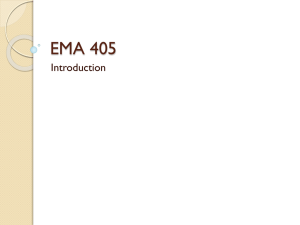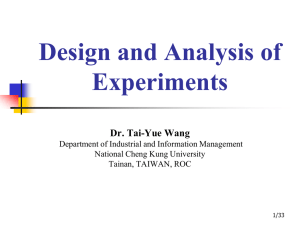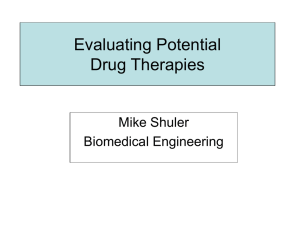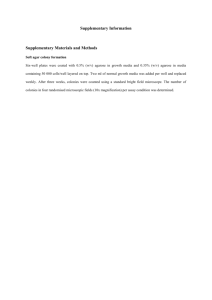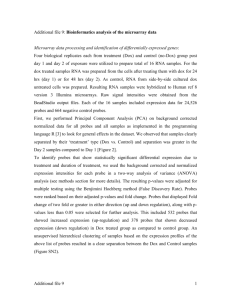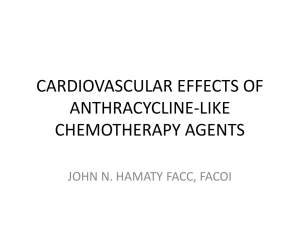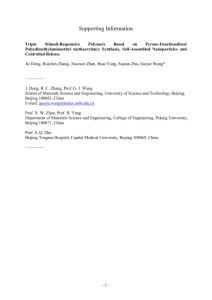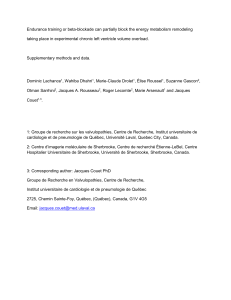Increased Serum and Cardiac Acyl-carnitine/Free Carnitine ratio
advertisement
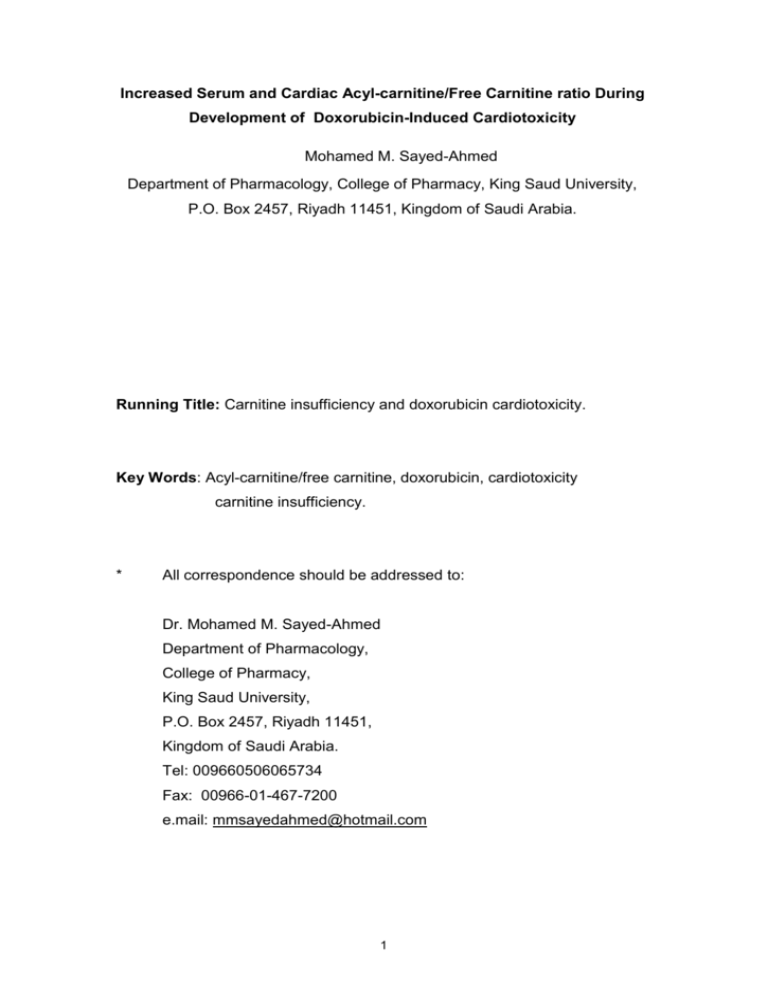
Increased Serum and Cardiac Acyl-carnitine/Free Carnitine ratio During Development of Doxorubicin-Induced Cardiotoxicity Mohamed M. Sayed-Ahmed Department of Pharmacology, College of Pharmacy, King Saud University, P.O. Box 2457, Riyadh 11451, Kingdom of Saudi Arabia. Running Title: Carnitine insufficiency and doxorubicin cardiotoxicity. Key Words: Acyl-carnitine/free carnitine, doxorubicin, cardiotoxicity carnitine insufficiency. * All correspondence should be addressed to: Dr. Mohamed M. Sayed-Ahmed Department of Pharmacology, College of Pharmacy, King Saud University, P.O. Box 2457, Riyadh 11451, Kingdom of Saudi Arabia. Tel: 009660506065734 Fax: 00966-01-467-7200 e.mail: mmsayedahmed@hotmail.com 1 Abstract This study has been initiated to investigate whether cumulative doxorubicin (DOX) therapy alters serum and cardiac carnitine levels and if so, whether these alterations should be viewed as a mechanism and/or as an index during development of DOX-induced cardiotoxicity. To achieve the ultimate goal of this study, a total of 40 adult male Wistar albino rats were divided into 4 groups. In the first group, animals were injected intraperitoneally (I.P.) with normal saline (0.5 ml/200 gm body weight) and served as a normal control. Animals in the second to the fourth groups were injected every other day with DOX (3 mg/kg, I.P.), to obtain treatments with cumulative doses of 6 mg/kg (group 2), 12 mg/kg (group 3) and 18 mg/kg (group 4). At 24 hours after receiving the last dose of DOX, animals were sacrificed, serum as well as hearts were isolated and analyzed. DOX induced a significant and dosedependent increase in serum creatine phosphokinase isoenzyme (CK-MB), lactate dehydrogenase (LDH), acyl-carnitine (AC)/free carnitine (FC) ratio and a significant decrease in serum free FC. In cardiac tissues, DOX induced a significant 46 % and 63 % decrease in FC after cumulative doses of 12 and 18 mg/kg, respectively. In contrast to FC, DOX induced a significant 70 % and 81 % increase in AC after cumulative doses of 12 and 18 mg/kg, respectively. Moreover, DOX treatment showed significant and dosedependent decrease in adenosine triphosphate (ATP) level in cardiac tissues. In conclusion, data from this study suggest that: (1) Decreased myocardial carnitine level should be viewed as a mechanism during development of DOX cardiotoxicity, and (2) the parallel increase of serum AC/FC ratio and cardiotoxicity enzymatic indices, may point to the possible consideration of AC/FC ratio as a marker during development of DOX cardiotoxicity. 2 Introduction Doxorubicin (DOX) was among the first anthracycline antibiotics to be in clinical use in cancer chemotherapy (1). It has a broad spectrum antitumour activity against a variety of solid and hematological tumours (2). Unfortunately, the optimal clinical usefulness of DOX is usually limited secondary to the development dose-dependent and irreversible cardiotoxicity (3). Several mechanistic studies have shown that DOX induces its cardiomyopathy through several events including generation of free radicals and lipid peroxidation of cardiac membranes (4,5), cardiac calcium overload (6), formation of DOX-iron complex (7) and inhibition of beta-oxidation of long chain fatty acids with the consequent depletion of cardiac ATP (8-11). In view of irreplaceability of DOX in cancer chemotherapy, one of the research aims being pursued most intensively is the possibility of eliminating its cardiotoxicity or reducing it to an acceptable level. In this regard, various drugs have been tried including L-carnitine (12-15) L-carnitine is a naturally occurring quaternary ammonium compound which is synthesized endogenously in kidney and liver and also obtained from dietary sources (16). L-Carnitine plays an essential role in transporting long fatty acids from the cytoplasmic compartment into mitochondria, where they are oxidized to produce energy (16). Inhibition of this vital pathway in the heart as a result of primary or secondary causes of carnitine deficiency has been shown to impair myocardial function (8,17). Moreover, decreased myocardial level of FC is thought to be part of the mechanism involved in the progression of DOX-induced heart failure and cardiomyopathy (11,12,17). Several experimental and clinical studies have demonstrated that L-carnitine has the potential ability to protect the myocardium against DOX-induced cardiotoxicity (18-22). In DOX-treated cancer patients, Yaris et al. (23), reported that there was a trend towards decreasing serum carnitine levels with increasing the cumulative doses of DOX. In contrast, Yoon et al. (20), have reported that DOX caused significant elevations of plasma FC, AC and total carnitine (TC). Results from these studies should be carefully reviewed because the level of carnitine fractions in the myocardium during development of DOX cardiotoxicity and its relationship to plasma carnitine level are not investigated. Therefore, this work has been initiated to investigate whether 3 cumulative doxorubicin (DOX) therapy alters serum and cardiac carnitine levels and if so, whether these alterations should be viewed as a mechanism and/or as a marker during development of DOX-induced cardiotoxicity. Materials and Methods Animals: Adult male Wistar albino rats, weighing 230-250 g, were obtained from the Animal Care Center, College of Pharmacy, King Saud University, Riyadh, Saudi Arabia. Animals were housed in metabolic cages under controlled environmental conditions (25oC and a 12 h light/dark cycle). Animals had free access to pulverized standard rat pellet diet essentially carnitine free and tap water unless otherwise indicated. The protocol of this study has been approved by Research Ethics Committee of College of Pharmacy, King Saud University, Riyadh, Saudi Arabia. Materials Doxorubicin was a generous gift from King Khalled University Hospital drug store. Free L-carnitine, short chain acyl-carnitine, and long chain acylcarnitine standards were kindly supplied by Dr. Menotti Calvani, Sigma-Tau, Pomezia, Italy. All other chemicals used were of the highest analytical grade. Experimental design and doxorubicin treatment protocol: In this study, the DOX treatment regimen (3 mg/kg every other day) used to develop the cumulative cardiotoxicity was adopted from Beanlands et al. (19) with slight modification in which animals were sacrificed 24 hours after cumulative doses of 6, 12 and 18 mg/kg. To achieve the ultimate goal of this study, a total of 40 adult male Wistar albino rats were used and divided at random into 4 groups of 10 animals each. In the first group, animals were injected intraperitoneally (I.P.) with normal saline (2.5 ml/kg) and served as a normal control. Animals in the second group were injected, every other day, with DOX (3 mg/kg, I.P.) over a period of 3 days to obtain cumulative dose of 6 mg/kg. Animals in the third group were injected, every other day, with DOX (3 mg/kg, I.P.) over a period of 7 days to obtain cumulative dose of 12 mg/kg. Animals in the fourth group were injected, every other day, with DOX (3 4 mg/kg, I.P.) over a period of 11 days to obtain cumulative dose of 18 mg/kg. At 24 hours after receiving the last dose of DOX, animals were anesthetized with ether, and blood samples were obtained from the retro-orbital sinus of the eye. Serum was separated for measurement of lactate dehydrogenase (LDH), creatine phosphokinase iso-enzyme (CK-MB), FC, AC, TC and AC/FC ratio. Immediately after blood samples were collected, animals were then sacrificed by decapitation after exposure to ether in a desiccator kept in a well-functioning hood and hearts were quickly excised, washed with saline, blotted with a piece of filter paper and homogenized in 6 % perchloric acid using a Branson sonifier (250, VWR Scientific, Danbury, Conn., USA). Assessment of cardiac enzymes: Serum activities of LDH and CK-MB were determined according to the methods of Buhl and Jackson ( 24) and Wu and Bowers (25), respectively. Determination of carnitine levels in serum and cardiac tissue. Heart homogenate was prepared in ice-cold 6 % perchloric acid and centrifuged at 8000 g for 10 minutes. Similarly, 1 ml of serum was mixed with 1 ml of ice-cold 6 % perchloric acid and centrifuged at 8000 g for 10 minutes. The tissue and serum supernatants were used for the estimation of FC and short chain AC, whereas the remaining pellets were used for determination of long chain AC after hydrolysis in 1 M KOH at 65 oC for I hour according to Alhomida (26). Carnitine fractions were then determined using high-pressure liquid chromatography after precolumn derivatization with L-aminoanthracene as previously described by Longo et al (27).The mobile phase was prepared by mixing 700 ml of 0.I M ammonium acetate pH 3.5 with 300 ml of acetonitrile. Chromatographic separation was performed at a flow rate of 1.3 ml/min, using a Kromasil C18, 250 x 4.6 mm I.D. 5 um column (Saulentechnik Knayer, Berlin, Germany). The excitation and emission wavelengths of the spectrofluorimeter were 248 and 418 nm respectively. Determination of adenosine triphosphate in cardiac tissue: Adenosine triphosphate was determined in heart tissues using HPLC according to Botker et al. (28). In brief, heart tissue was homogenized in icecold 6 % perchloric acid, centrifuged at 3000 rpm for 15 min at 0.5 oC, and the supernatant fluid was injected into HPLC after neutralization to pH 6-7. Chromatographic separation was performed at a flow rate of 1.2 ml/min, using 5 ODS-Hypersil, 150 X 4.6 mm I.D., 5 um column (Supelco SA, Gland, Switzerland) and 75 mM ammonium dihydrogen phosphate as mobile phase. The peak elution was followed at 254 nm. Statistical analysis: Differences between obtained values (mean ± SEM, n = 10) were carried out by one way analysis of variance (ANOVA) followed by the Tukey-Kramer multiple comparison test. A P value of 0.05 or less was taken as a criterion for a statistically significant difference. Results The cumulative cardiotoxicity of DOX was clearly featured by the dosedependent increase in serum cardiac enzymes CK-MB and LDH (table 1). At the highest cumulative dose, 18 mg/kg, DOX resulted in a significant 178 % and 154 % increase in CK-MB and LDH, respectively, as compared to the control group. Table 2 shows the effect of different cumulative doses of DOX on serum FC, AC, TC, and AC/FC ratio in rats. DOX therapy resulted in dose-dependent decrease in FC with the maximum (42 %) decrease was observed at a dose of 18 mg/kg. In contrast to FC, the level of AC showed a significant 128 % and 226 % increase after cumulative DOX doses of 12 and 18 mg/kg, respectively, as compared to the control group. Moreover, DOX treatment resulted in a significant and dose-dependent increase in AC/FC ratio with the maximum (440 %) increase at the highest cumulative dose of DOX (18 mg/kg). Table 3 shows the effect of different cumulative doses of DOX on the levels of FC, AC, TC, and AC/FC ratio in rat heart tissues. Treatment with DOX resulted in a significant 46 % and 63 % decrease in FC at cumulative doses of 12 and 18 mg/kg, respectively, as compared to the control group. In contrast to FC, the level of AC showed a significant 70 % and 81 % increase after cumulative DOX doses of 12 and 18 mg/kg, respectively. Moreover, DOX treatment resulted in a significant and dose-dependent increase in AC/FC ratio with the maximum (400 %) increase at the highest cumulative dose of DOX (18 mg/kg). 6 To investigate the effect of DOX on mitochondrial function and energy production, the level of ATP was measured in cardiac tissues (table 4). DOX resulted in a significant 39 % and 45 % decrease in ATP level after cumulative doses of 12 and 18 mg/kg, respectively, as compared to the control group. Discussion L-carnitine performs a crucial role in the energy production in the heart by controlling the influx of long chain fatty acids into mitochondria (16). The total body content of carnitine in adults amounts to 50-100 mmol, most of it being localized in skeletal muscles (29). Carnitine is present in both plasma and tissue as FC or bound to fatty acids as AC with relatively high concentration in cardiac tissues (14). Under normal physiological conditions, 80 % of total serum carnitine is FC and 20 % is AC with normal AC/FC ratio of 0.25 (30,31). Earlier studies reported that increased ratio of AC/FC greater than 0.4 is abnormal and creates a pathological condition known as carnitine insufficiency in which there is insufficient FC relative to increased metabolic needs (30-32). Moreover, it has been reported that AC/FC ratio is very sensitive to metabolic changes and equals to the intramitochondrial acyl-CoA/CoA-SH ratio (32). Data presented here demonstrate that DOX increased serum cardiotoxicity enzymatic indices (LDH and CK-MB). This effect could be a secondary event following DOX-induced lipid peroxidation of cardiac membranes with the consequent increase in the leakage of LDH and CK-MB. Increased release of cardiac enzymes by DOX had been previously reported (5,11,33) In cardiac tissues, the observed decrease in both FC and TC after DOX treatment was dose-dependent with the maximum decrease at the highest cumulative dose (18 mg/kg). This decrease in FC and TC levels in cardiac tissue was parallel to the increase in cardiotoxicity enzymatic indices, LDH and CK-MB, which may point to the possible role of decreased myocardial carnitine during development of DOX-induced cardiotoxicity. 7 Decreased cardiac carnitine content has been previously reported in many forms of DOX-dependent and independent cardiomyopathies (11,12,17,30,34) In contrast to FC and TC, DOX treatment caused dose-dependent accumulation of AC and AC/FC ratio in cardiac tissues (table 3). This effect could be a secondary event following the decrease in FC with the consequent inhibition of long chain fatty acid oxidation and accumulation of toxic fatty acid intermediates including long chain acyl-CoA and long chain AC. It is well documented that these intermediates are amphiphilic and have detergent-like effects, altering membrane integrity, inhibiting several membrane-bound enzymes, provoking free radical injury and decreasing myocardial contractility (35). Increased AC in the heart by DOX could be explained on the basis that impaired mitochondrial function leads to esterification of FC with acyl groups. This results in progressive reduction of the FC pool in the heart which could lead to a metabolically deleterious carnitine insufficiency (30). It is well known that liver and kidney are the main organs responsible for the endogenous synthesis of FC which is then transported into cardiac and skeletal muscles (16). Therefore, in the current study, the observed decrease in myocardial FC could be a secondary event following DOX-induced inhibition of the endogenous synthesis of FC. This hypothesis is supported by reports from several recent studies which have demonstrated that DOX therapy is associated with severe hepatotoxicity (36,37) ) and nephrotoxicity (38-40 ) and that L-carnitine supplementation have the potential ability to protect against DOX-induced renal and hepatic dysfunction (38,41). Moreover, in vitro and in vivo studies have reported that DOX inactivates cardiac carnitine palmitoyltransferase1 by competing with L-carnitine for its binding site on the enzyme, and increases the leakage of L-carnitine from cardiac myocytes (9,20). Contrary to our results, McFalls et al. (42) reported that cardiac carnitine levels were not significantly changed by DOX (2 mg/kg/week, for 6 weeks). This discrepancy between our results and the aforementioned study could be due to the difference in experimental design regarding the dosing and schedule of DOX therapy and the time of carnitine assessment. 8 In this study, the observed increase in serum AC and AC/FC ratio were parallel to their increase in the heart. This effect could be a consequence of carnitine insufficiency when esterified carnitine is exported out of the mitochondria. Previous study reported that increased serum AC could indicate impaired transport of long chain fatty acids into mitochondria and abnormal beta-oxidation pathway (30). Moreover, the observed increase in serum AC/FC ratio by DOX was dose-dependent and parallel to the increase in cardiotoxicity enzymatic indices, LDH and CK-MB, which may point to the possible consideration of serum AC/FC ratio as an index of DOX-induced cumulative cardiotoxicity. It is well known that L-carnitine is an essential cofactor for mitochondrial transport and oxidation of long chain fatty acids which are the preferred substrates for ATP production in normal, welloxygenated adult myocardium (43). Depletion of the heart from carnitine by DOX therapy would impair the beta-oxidation of long chain fatty acids with the consequent decrease in ATP production and heart contractile function. This was supported by the marked decrease of ATP levels in heart tissues observed after the higher cumulative dose of DOX (table 4). This hypothesis is supported by the data presented in previous studies which have reported that carnitine supplementation completely reversed the development of DOXinduced cardiotoxicity by replenishing the myocardium with adequate carnitine for its energy production (9,13,17). In conclusion, data from this study suggest that: (1) Decreased myocardial carnitine level should be viewed as a mechanism during development of DOX cardiotoxicity, (2) serum AC/FC ratio could be used as a marker during development of DOX cardiotoxicity. This will open new perspectives for monitoring serum levels of FC, AC, and AC/FC ratio in cancer patient receiving DOX-containing combination chemotherapy protocols. Acknowledgements: The present work was supported by operating grants from Research Center, College of Pharmacy, King Saud University (CPRC 171). 9 References 1. Arcamone F, Cassinelli G, Fantini G, Grein A, Orezzi P, Pol C, Spalla C. Adriamycin, 14-hydroxydaunomycin, a new antitumor antibiotic. Tetrahedron Lett 1969; 13: 1007-1010. 2. Carter SK. Adriamycin-a review. J Natl Cancer Inst 1975; 55: 1265-1274. 3. Kantrowitz NE and Bristow MR. Cardiotoxicity of antitumour agents. Prog Cardiovasc Dis 1984; 27:195-200. 4. Al-Shabanah O, Mansour M, el-Kashef H, al-Bekairi A. Captopril ameliorates myocardial and hematological toxicities induced by adriamycin. Biochem Mol Biol Int 1998; 45:419-427. 5. El-Demerdash E, Azza AA, Sayed-Ahmed MM and Osman AM. New aspects in probucol cardioprotection against doxorubicin-induced cardiotoxicity. Cancer Chemother and Pharmacol 2003; 52: 411-416. 6. Rossi F, Filippelli W, Russo S, Filippelli A, Berrino L. Cardiotoxicity of doxorubicin: effects of drugs inhibiting the release of vasoactive substances. Pharmacol Toxicol 1994;75: 99-107. 7. Al-Harbi MM, al-Gharably NM, al-Shabanah OA, al-Bekairi AM, Osman AM,Tawfik HN. Prevention of doxorubicin-induced myocardial and haematological toxicities in rats by the iron chelator desferrioxamine. Cancer Chemother Pharmacol. 1992; 31: 200-204. 8. Abdel-aleem S, el-Merzabani MM, Sayed-Ahmed M, Taylor DA, Lowe JE. Acute and chronic effects of adriamycin on fatty acid oxidation in isolated cardiac myocytes. J Mol Cell Cardiol 1997; 29:789-797. 9. Sayed-Ahmed MM, Shaarawy S, Shouman SA, Osman AM. Reversal of doxorubicin-induced cardiac metabolic damage by L-carnitine. Pharmacol Res 1999; 39: 289-295. 10. Sayed-Ahmed MM, Shouman SA, Rezk BM, Khalifa MH, Osman AM, El-Merzabani MM. Propionyl-L-carnitine as potential protective agent against adriamycin-induced impairment of fatty acid beta-oxidation in isolated heart mitochondria. Pharmacol Res 2000 ; 41:143-150. 11. Sayed-Ahmed MM, Salman TM, Gaballah HE, Abou El-Naga SA, Nicolai R, Calvani M. Propionyl-L-carnitine as protector against 10 adriamycin-induced cardiomyopathy. Pharmacol Res 2001; 43: 513-520. 12. Strauss M, Anselmi G, Hermoso T, Tejero F. Carnitine promotes heat shock protein synthesis in adriamycin-induced cardiomyopathy in a neonatal rat experimental model. J Mol Cell Cardiol 1998; 30: 2319-25. 13. Andrieu-Abadie N, Jaffrezou JP, Hatem S, Laurent G, Levade T, Mercadier JJ. L-carnitine prevents doxorubicin-induced apoptosis of cardiac myocytes: role of inhibition of ceramide generation. FASEB J. 1999;13: 1501-1510. 14. Luo X, Reichetzer B, Trines J, Benson LN, Lehotay DC. L-carnitine attenuates doxorubicin-induced lipid peroxidation in rats. Free Radic Biol Med 1999; 26: 1158-1165. 15. De Leonardis V, Neri B, Bacalli S, Cinelli P. Reduction of cardiac toxicity of anthracyclines by L-carnitine: preliminary overview of clinical data. Int J Clin Pharmacol Res 1985; 5: 137-142. 16. Goa KL, Brogden RN. L-carnitine. Drugs 1987; 34: 1-24. 17. Kawasaki N, Lee JD, Shimizu H, Ueda T. Long-term 1-carnitine treatment prolongs the survival in rats with adriamycin-induced heart failure. J Card Fail 1996; 2: 293-299. 18. De Leonardis V, De Scalzi M, Neri B, Bartalucci S, Cinelli P. Echocardiographic assessment of anthracycline cardiotoxicity during different therapeutic regimens. Int J Clin Pharmacol Res 1987; 7: 307-311. 19. Beanlands RS, Shaikh NA, Wen WH, Dawood F, Ugnat AM, McLaughlin PR, Carere R, Liu PP. Alterations in fatty acid metabolism in adriamycin cardiomyopathy. J Mol Cell Cardiol 1994; 26: 109-119. 20. Yoon HR, Hong YM, Boriack RL, Bennett MJ. Effect of L-carnitine supplementation on cardiac carnitine palmitoyltransferase activities and plasma carnitine concentrations in adriamycin-treated rats. Pediatr Res. 2003; 53: 788-792. 21. Waldner R, Laschan C, Lohninger A, Gessner M, Tuchler H, Huemer M, Spiege lW, Karlic H. Effects of doxorubicin-containing 11 chemotherapy and a combination with L-carnitine on oxidative metabolism in patients with non-Hodgkin lymphoma. J Cancer Res Clin Oncol 2006; 13: 121-128. 22. Delaney CE, Hopkins SP, Addison CL. Supplementation with l-carnitine does not reduce the efficacy of epirubicin treatment in breast cancer cells. Cancer Lett 2007 (ahead of print). 23. Yaris N, Ceviz N, Coskun T, Akytuz C, Buyukpamukcu M. Serum carnitine levels during the doxorubicin therapy. Its role in cardiotoxicity. J Exp Clin Cancer Res. 2002; 21: 165-170. 24. Buhl SN, Jackson KY. Optimal conditions and comparison of lactate dehydrogenase catalysis of the lactate-to-pyruvate and pyruvate-tolactate reactions in human serum at 25, 30, and 37 degrees C. Clin Chem 1978; 24: 828-831. 25. Wu AHB, Bowers CN. Evaluation and comparison of immunoinhibition and immunopreceptation methods for differentiating MB and BB from macro forms of creatine kinase isoenzymes in patients and healthy individuals. Clin Chem 1982; 28: 2017-2021. 26. Alhomida AS. Study of the effects of theophylline-related changes in total, free, Short chain acyl and long-chain acyl carnitine concentrations in rat heart. Toxicol 1997; 121: 205-213. 27. Longo A, Bruno G, Curti S, Mancinelli A, Miotti G. Determination of L-carnitine, acetyl-L-carnitine and propionyl-L-carnitine in human plasma by high-performance liquid chromatography after pre-column derivatization with I-aminoanthracene. J Chromatogr B Biomed Appl 1996; 686: 129-139. 28. Botker HE, Kimose M, Helligso P, Nielsen TT. Analytical evaluation of high-energy phosphate determination by high performance liquid chromatography in myocardial tissue. J Mol Cell Cardiol 1994; 26: 41-48. 29. Marthaler NP, Visarius T, Kupfer A, Lauterburg BH. Increased urinary losses of carnitine during ifosfamide chemotherapy. Cancer Chemother Pharmacol 1999; 44:170-172. 12 30. Campos Y, Huertas R, Lorenzo G, Bautista J, Gutierrez E, Aparicio M, Alesso L, Arenas J. Plasma carnitine insufficiency and effectiveness of L-carnitine therapy in patients with mitochondrial myopathy. Muscle Nerve 1993;16:150-153. 31. Bohles H, Evangeliou A, Bervoets K, Eckert I, Sewell A. Carnitine esters in metabolic disease. Eur J Pediatr. 1994;153: S57-S61. 32. Winter SC, Zorn EM, Vance WH. Carnitine deficiency. Lancet 1990; 1: 981-982. 33. Sayed-Ahmed MM, Khattab MM, Gad MZ, Osman AM. Increased plasma endothelin-1 and cardiac nitric oxide during doxorubicininduced cardiomyopathy. Pharmacol Toxicol 2001;89: 140-144. 34. Famularo G, Matricardi F, Nucera E, Santini G, De Simone C. Carnitine Deficiency: Primary and secondary syndromes. In: Carnitine Today, De Simone C and Famularo G (eds), Landes Bioscience, Springer, PP 119-161. 35. Schaap FG, van der Vusse GJ, Glatz JF. Fatty acid-binding proteins in the heart. Mol Cell Biochem 1998;180: 43-51. 36. Kalender Y, Yel M, Kalender S. Doxorubicin hepatotoxicity and hepatic free radical metabolism in rats. The effects of vitamin E and catechin. Toxicology 2005; 209: 39-45. 37. Kwiecien I, Michalska M, Wlodek L. The selective effect of cystathionine on doxorubicin hepatotoxicity in tumor-bearing mice. Eur J Pharmacol 2006; 550: 39-46. 38. Boonsanit D, Kanchanapangka S, Buranakarl C. L-carnitine ameliorates doxorubicin-induced nephrotic syndrome in rats. Nephrology (Carlton) 2006;11: 313-320. 39. Liu LL, Li QX, Xia L, Li J, Shao L. Differential effects of dihydropyridine calcium antagonists on doxorubicin-induced nephrotoxicity in rats. Toxicology 2007; 231: 81-90 40. Abd-Ellah MF, Mariee AD: Ginkgo biloba leaf extract (EGb 761) diminishes adriamycin-induced hyperlipidaemic nephrotoxicity in rats: association with nitric oxide production. Biotechnol Appl Biochem 2007 ;46: 35-40. 13 41. Zeidan Q., Strauss M., Porras N., Anselmi G.: Differential long-term subcellular responses in heart and liver to adriamycin stress. Exogenous L-carnitine cardiac and hepatic protection. J Submicrosc Cytol Pathol 2002; 34: 315-321. 42. McFalls EO, Paulson DJ, Gilbert EF, Shug AL. Carnitine protection against adriamycin-induced cardiomyopathy in rats. Life Sci 1986; 38:497-505. 43. Neely JR, Morgan HE. Relationship between carbohydrate and lipid metabolism and the energy balance of heart muscle. Annu Rev Physiol 1974; 36: 413-459. 14 Table (1): Effect of doxorubicin on serum cardiomyopathy enzymatic indices, creatine phosphokinase isoenzyme (CK-MB) and lactate dehydrogenase (LDH), in rats. Treatment groups CK-MB (U/L) LDH (U/L) 2.563 ± 8.2 312.4 ± 12.4 Doxorubicin, 6 mg/kg 5.462 ± 24.5 * 482.1 ± 19.2* Doxorubicin, 12 mg/kg ..16. ± 42.1*,# 748.2 ± 29.5*,# Doxorubicin, 18 mg/kg 1.1461 ± 53.4*,# 792.6 ± 33.8*,# Control Data are presented as mean ± SEM (n =10). * and # indicate significant change from control and DOX (6 mg/kg), respectively, at p<0.05 using ANOVA followed by Tukey-Kramer as a post ANOVA test. 15 Table (2): Effect of doxorubicin on serum free carnitine (FC), acyl carnitine (AC), total carnitine (TC) and AC/FC ratio in rats. Treatment groups Serum carnitine level (mol/l) FC AC TC AC/FC Control 48.8 ± 5.1 14.1 ± 2.1 63.0 ± 6.3 0.3 ± 0.1 Doxorubicin, 6 mg/kg 40.3 ±4.2 3.65 ± 3.3 66.6 ± 6.4 0.66 ± 0.26 Doxorubicin, 12 mg/kg 36.5 ± 3.0 2363 ± 4.0* 68.5 ± 6.7 0.88 ± 0.28 Doxorubicin, 18 mg/kg 3162 ± 3.2* 4.6. ± 5.4*,# 74.3 ± 5.6 1.62 ± 0.17*,# Data are presented as mean ± SEM (n =10). * and # indicate significant change from control and DOX (6 mg/kg), respectively, at p<0.05 using ANOVA followed by Tukey-Kramer as a post ANOVA test. 16 Table (3): Effect of doxorubicin on free carnitine (FC), acyl carnitine (AC), total carnitine (TC) and AC/FC ratio in rat heart tissues. Treatment groups Cardiac carnitine level (nmol/ g wet tissue) FC AC TC AC/FC Control 702 ± 88.3 3.163 ± 12.5 903.6 ± 68.3 0.28 ± 0.01 Doxorubicin, 6 mg/kg 533 ± 31.4 267.1 ± 9.8 800.1 ± 52.8 0.50 ± 0.05 Doxorubicin, 12 mg/kg 382 ± 16.1* 342.5 ±22.6*,# 724.7 ± 44.0 0.89 ± 0.13 Doxorubicin, 18 mg/kg 35. ±12.4*,# 364 ± 21.4*,# 623 ± 39.4* 1.40 ± 0.38*,# Data are presented as mean ± SEM (n =10). * and # indicate significant change from control and DOX (6 mg/kg), respectively, at p<0.05 using ANOVA followed by Tukey-Kramer as a post ANOVA test. 17 Table (4): Effect of doxorubicin on adenosine triphosphate level in rat heart tissues. Treatment groups Adenosine triphosphate (ATP) (nmol/g wet tissue) Control 851. 3 ± 32.4 Doxorubicin, 6 mg/kg 780.2 ± 36.5 Doxorubicin, 12 mg/kg 518.6 ± 21.5*,# Doxorubicin, 18 mg/kg 472.3 ± 15.1*,# Data are presented as mean ± SEM (n =10). * and # indicate significant change from control and DOX (6 mg/kg), respectively, at p<0.05 using ANOVA followed by Tukey-Kramer as a post ANOVA test. 18 19
